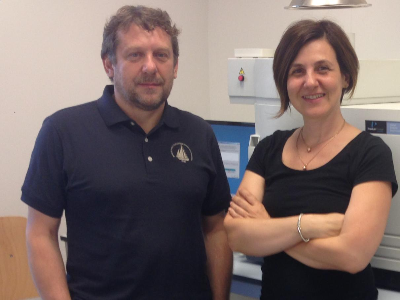Unimore researchers discover a mechanism for regulating the temperature in the deep magma source

Researchers of the University of Modena and Reggio Emilia have discovered a mechanism for regulating the temperature in the deep magma source. Carried out by professor Daniele Brunelli of Unimore, professor Anna Cipriani of Unimore, and their colleague Enrico Bonatti, the study was published on the last number of Nature Geoscience, the famous international scientific magazine.
The volcano activity of the Earth is almost totally invisible to the eye. More than three quarters of the magma generated on the Earth is erupted on the seabed of the oceans along the ridges running through the central axis of oceanic basins.
The research group of geologists from the Department of Chemical and Geological Sciences in Modena has been participating for several years to international oceanographic expeditions that also saw the involvement of students of the University. It was this research and observation programme that made it possible to find out the mechanism for regulating the temperature of the planet in the region where magmas are generated.
As professor Daniele Brunelli and his colleague, professor Anna Cipriani of Unimore, explain “Our finding reveals an unexpected behaviour limiting the production of magmas as a consequence of the cooling caused by the melting of a minor portion of the Earth mantle (pyroxenes) against the melting of the hosting rock (peridotites). This mechanism involves millions of cubic kilometres of rock in the layer between 40 and 100 km of depth under the oceanic ridges, where basaltic magmas and the new oceanic crust are generated. The same mechanism is active in the source of continental volcanoes, for which our study provides a key for interpreting the fluctuations of magma activity over time. The volcanic activity also controls the climate of the planet on a long-term basis. Therefore, the time study of a magma sequence like the one described in our research helps recognise the contribution of volcanic phenomena to climate changes throughout geological eras.
Next year, an oceanographic campaign coordinated by professor Daniele Brunelli, together with geophysics of the Université Européenne de la Mer in Brest (France), will take the Unimore researchers to the Equatorial Atlantic sea to study the volcanic events in one of the deepest areas of this ocean.
The geochemical analysis coordinated by professor Anna Cipriani of Unimore, with the participation of doctoral students of the PhD school belonging to the Department of Chemical and Geological Sciences, will allow the researchers to deepen the recent discovery and define the parameters controlling it.
Daniele Brunelli
He has been an associate professor of Petrography and Petrology at the Department of Chemical and Geological sciences of the University of Modena and Reggio Emilia since October 2014. He was awarded the degree with honour in Geological Sciences at the University of Padua, and afterwards in 2002 he obtained the PhD in Earth Sciences at the University of Bologna. From 2002 to 2006, he has been a Postdoctoral research scientist at the CNRS-INSU Institut de Physique du Globe (Paris, FR) and the CNRS-Laboratoire Pierre Sue (Saclay, FR) within the EUROMELT project sponsored by the European Research Training Network. He came back to Italy in 2007 as a researcher at the Department of Earth Sciences of UNIMORE and in 2008 even became an associated researcher at the CNR-ISMAR in Bologna. Daniele has been studying all petrological and geochemical processes that lead to the creation of the oceanic crust and its variation over time, and the interaction among melts and rocks of the sub-oceanic and subcontinental mantel. During the last years, he has been studying the geochemical cycle of carbon and traces of organic matter in the oceanic mantle. He took part in several oceanographic expeditions in the Mediterranean Sea, in the Atlantic Ocean, in the Indian Ocean, and in the Periantarctic oceans. He coordinates the Interridge study team “Oceanic transform fault”.
Anna Cipriani
She has been an associate professor of Geochemistry and Volcanology at the Department of Chemical and Geological sciences of the University of Modena and Reggio Emilia since November 2015. She was awarded the degree with honour in Geological Sciences at the University of Padua, and afterwards in 2004 he obtained a Master in Philosophy (2007) in Earth and Environmental Sciences at the Columbia University (USA). Since 2007, she has been carrying out her research as a Postdoctoral Research Scientist at the Lamont-Doherty Earth Observatory, where she is still an Adjunct Associate Research Scientist. In 2011 she came back to Italy as a temporary researcher working in the “Rita Levi Montalcini” young researchers programme. She has specialised in using the elementary and isotopic geochemistry to explain various geological processes occurring into the depths of the Earth and also on the surface, through the study of outcrops of xenoliths and crust and mantle rocks of the ocean floor and ophiolitic massifs. She took part into several oceanographic expeditions in the Atlantic Ocean, in the Indian Ocean, in Periantarctic oceans, and in the Red Sea. More recently, her work widened to include the application of the techniques for the geochemical analysis to archaeology and anthropology to examine patterns of human mobility.
Categorie: International - english
Articolo pubblicato da: Ufficio Stampa Unimore - ufficiostampa@unimore.it il 25/06/2018

